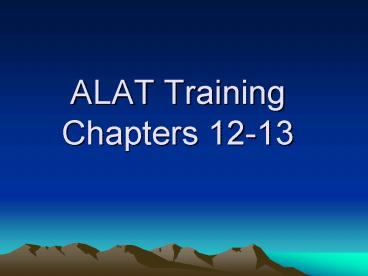ALAT Training Chapters 1213 - PowerPoint PPT Presentation
1 / 26
Title:
ALAT Training Chapters 1213
Description:
Multiple Choice: Who is usually the first person to identify, document and report ... Antiprotozoal. Anesthetic. d) Anesthetic. Syphacia mesocriceti. Drugs. 200 ... – PowerPoint PPT presentation
Number of Views:192
Avg rating:3.0/5.0
Title: ALAT Training Chapters 1213
1
ALAT Training Chapters 12-13
2
Recognition of Disease 100
- Multiple Choice Who is usually the first person
to identify, document and report a sick animal? - Principal Investigator
- Animal Technician
- Lab Animal Veterinarian
- Research Technician
b) Animal Technician
3
Recognition of Disease 200
- Define ALOPECIA
Hair Loss
4
Recognition of Disease 300
- Name two clinical signs seen in sick mice
Hunched posture Scruffy hair coat Emaciation
(thin) Reluctant to eat and/or drink
5
Recognition of Disease 400
- Multiple Choice Dyspnea frequently indicates a
problem with which body system? - Urogenital
- Integument
- Respiratory
- Gastrointestinal
c) Respiratory
6
Recognition of Disease 500
- Define Pruritus
Excessive scratching (persistent itch)
7
Disease 100
- Define Disease
Any alteration of normal anatomy or physiology
8
Disease 200
- Multiple Choice Circadian rhythm refers to
- Rate that crickets reproduce
- Direction that circling mice circle
- A specific light/dark cycle
- Sound cicadas make at night
c) A specific light/dark cycle
9
Disease 300
- Name three TYPES of disease-causing organisms.
Viruses, Bacteria, Fungi, Protozoa, Helminths,
Arthropods
10
Disease 400
- Multiple Choice Any living organism that carries
(transmits) disease-causing microbes (infectious
agents) is a - Fomite
- Mutation
- Vector
- Research Technician
c) Vector
11
Disease 500
- Multiple Choice Which of the following are
important parts of a good Health Monitoring
program? - Sentinels and vaccinations
- Soiled cage bedding and fresh food
- Sentinels, necropsy and blood testing
- Blood testing, food analysis and biohazards
c) Sentinels, necropsy and blood testing
12
Drugs100
- Multiple Choice Which of the following doesnt
fit in this list? - Anthelmintic
- Insecticide
- Antiprotozoal
- Anesthetic
d) Anesthetic
13
Drugs 200
- Multiple Choice The word used to describe when
drugs are administered into muscle is - Intraperitoneal (IP)
- Intracardiac (IC)
- Intramuscular (IM)
- Subcutaneous (SQ)
c) Intramuscular (IM)
14
Drugs 300
- Multiple Choice Which parenteral injection
method is most dangerous? - Subcutaneous (SQ)
- Intradermal (ID)
- Intravenous (IV)
- Intracardiac (IC)
d) Intracardiac (IC)
15
Drugs 400
- Multiple Choice Which words go together the
best? - Gavage/Oral
- Topical/Intradermal
- Inhalation/Antibiotic
- Rectal/Intraperitoneal
a) Gavage/Oral
16
Drugs 500
- Multiple Choice Which of the following does not
belong? - Isoflurane
- Carbaryl
- Ketamine
- Buprenorphine
b) Carbaryl
17
Diseases and Records 100
- Multiple Choice At the LASC, an abnormal
condition in an animal is recorded on - A green card, the problem log
- A blue card
- The problem log
- The animal health summary sheet
a) The problem log
18
Diseases and Records 200
- Multiple Choice Typical signs of respiratory
disease include - Coughing, sneezing, nasal discharge
- Paralysis, alopecia
- Diarrhea, vomiting
- Bleeding, rectal prolapse
a) Coughing, sneezing, nasal discharge
19
Diseases and Records 300
- Multiple Choice All entries in a health record
or problem log should contain - Facts and interpretations
- Technicians initials and date
- Date and interpretations of findings
- Animal I.D. and temperature
b) Technicians initials and date
20
Diseases and Records 400
- Multiple Choice (two) Eating a large amount of
a toxic substance will cause - a) Infectious disease
- b) Noninfectious disease
b) Noninfectious disease
21
Diseases and Records 500
- Multiple Choice What happens at the LASC after
a technician puts a Green card on a sick animals
cage? - Lab Animal veterinarian examines animal
- Research Technician calls the PI
- Supervisor examines animal, contacts PI and makes
notes in problem log - Animal technician treats animal with antibiotics
c) Supervisor examines animal, contacts PI and
makes notes in problem log
22
All Together Now 100
- Multiple Choice Isolation of a sick animal
means - It is separated from healthy animals
- It is vaccinated against common disease causing
organisms - It is euthanized
- It is incinerated
a) It is separated from healthy animals
23
All Together Now 200
- Multiple Choice A typical weanling mouse is
about ___ weeks old and weighs about ___ grams. - 2 weeks, 30 grams
- 2 weeks, 15 grams
- 3 weeks, 30 grams
- 3 weeks, 15 grams
d) 3 weeks, 15 grams
24
All Together Now 300
- Two Choices If a tumor is described as being
on the caudal part of a rabbits chest, it is
closer to her - Head
- Tail
b) Tail
25
All Together Now 400
- Multiple Choice 22 C is __F?
- 12
- 1.8
- 72
- 84
c) 72 (1.8 x 22) 32
26
All Together Now 500
- Two Choices The pulmonary artery takes blood
______ the heart. - to
- from
a) to































